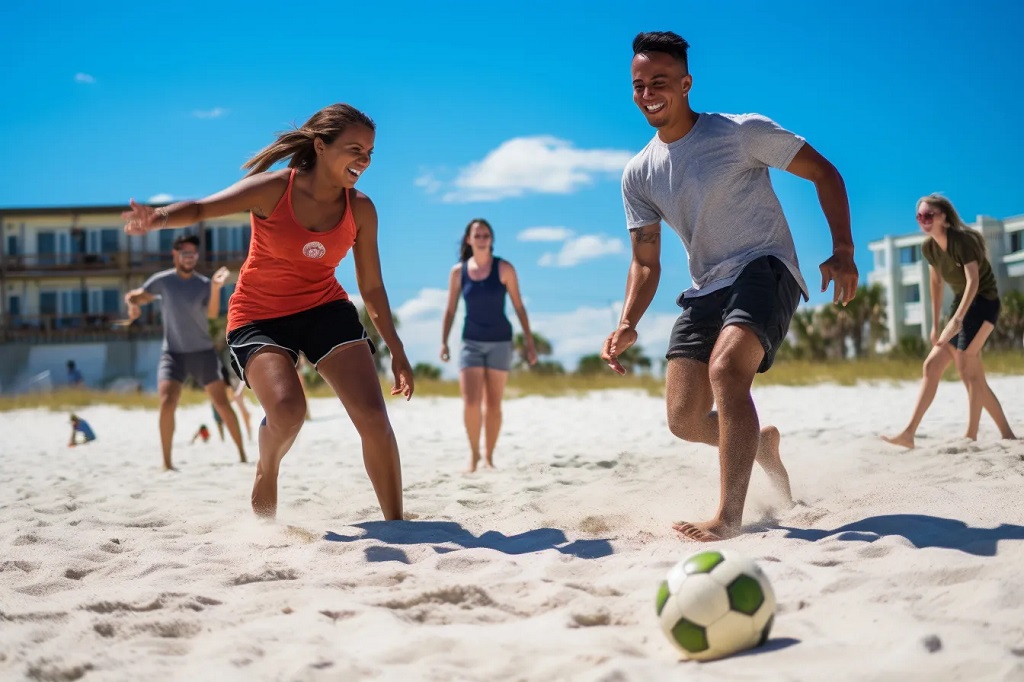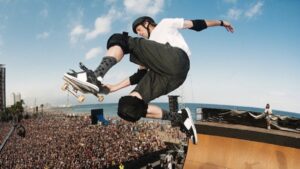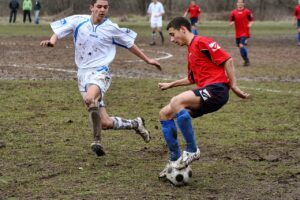Beach football, also called beach soccer, is a unique and exciting variant of association football, played on a sandy surface rather than traditional grass. The game is quite similar to the conventional football we are all familiar with but with a few significant modifications to accommodate the soft and unstable playing surface. For instance, teams consist of five players each, and the game is played in three 12-minute periods, with a 3-minute break between each period.
The goalkeepers are not allowed to leave their designated area, and the throw-ins are taken with one hand, among other notable variations. Beach football is an exhilarating, fast-paced, and highly entertaining sport favored by many football enthusiasts worldwide due to its combination of skill, agility, and athleticism and the unique thrill of playing in an outdoor beach environment.
Overview of Beach Football

Beach football is played with substantially fewer players than regular football. Each team has five players on the field at a time, with a maximum of 12 players on the roster. The field is also smaller – about 35-37 meters long and 26-28 meters wide. Players compete barefoot to better grip the sand.
The actual rules of beach football closely mirror the laws of the game in regular football. Two teams compete to kick or head the ball into the opposing team’s goal. Games consist of three periods of 12 minutes each. Substitutions are unlimited and typically occur “on the fly” while the ball is in play.
While similar to traditional 11-a-side football, beach football emphasizes different skills and tactics. Running in sand requires more exertion and attention to footwork. Passing and shooting need to be precise. Physical conditioning, stamina, agility, and excellent ball control are paramount. Games often involve nearly continuous attacking play with plenty of goals scored!
Equipment Needed
One of the great things about beach football is very little equipment is required. Here is the essential gear you’ll need:
- Ball – A size five football is used. The ball needs some bounce and absorb surface impact on the sand. A FIFA-approved beach football works best.
- Goals – Small portable goals can be used. 5 to 6.5 feet wide and around 5 feet tall is standard. Use stakes or sandbags to secure them in place.
- Team Uniforms – Barefoot is best for traction and safety. Team shirts are commonly worn. Avoid footwear and jewelry that could be dangerous.
- Field Lines – Use corner flags to mark the boundaries. Lines in the sand demarcate touch lines and goal areas.
- Match Clock – Keep track of the 3 x 12-minute periods: stopwatches or a countdown timer app on a phone work fine.
That’s it for the required equipment! The bare essentials allow playing beach football almost anywhere there is ample sand.
Basic Rules and Regulations
Beach football follows the main rules and regulations of traditional football with some variations:
- Number of Players – Each team has five players on the field. Squads can have up to 12 players.
- Substitutions – Subbing can occur while the ball is in play.
- Duration – Games are split into three periods of 12 minutes each. A 3-minute break occurs between periods.
- Kickoffs – Kickoffs are used to start play each half and after goals. The ball must go forward first.
- Direct and Indirect Free Kicks – All free kicks are direct. Walls cannot be formed by the defense on free kicks.
- Goalkeepers – There are no goalkeepers in beach football. All players can play anywhere.
- Yellow/Red Cards – The disciplinary system is the same. Yellow card is a caution, two yellows leads to a red ejection.
- Offside – There are no offside infractions when attacking. Players can’t loiter near the opposing goal.
- Boundary Lines – The ball must stay within the marked side and goal lines. It can bounce off the goal frame and remain in play.
- Corner Kicks – When the defense puts the ball across the goal line, corner kicks are awarded.
The simplicity of beach football rules means games flow quickly. Far less time is spent on restarts and set pieces than regular football.
Player Positions and Roles
While beach football teams are much smaller, traditional positions and responsibilities still apply:
- Striker – Tasked with scoring goals. They have excellent shooting ability with both power and accuracy. Good dribbling skills to take on defenders.
- Winger – Playing on the left or right flank, wingers speed down the touchlines. They can rip long shots and drill accurate crosses to the striker. Pace and 1v1 skills are vital.
- Center midfielder – Supports both attack and defense from box to box. He needs excellent stamina to run the entire game. Able to win back possession and quickly distribute the ball upfield.
- Defender – Mark opponents tightly and win back the ball. They time tackle well in sandy conditions. Focus on forcing offenses away from the goal or into low-percentage shots.
- Goalkeeper – While goalkeepers aren’t used, all players should have some shot-stopping ability. During defensive pressure, they focus on blocking close-range shots on goal.
Players need to flow between positions seamlessly. The small number on the field requires well-rounded skills both offensively and defensively.
Player Traits for Beach Football
Beach football demands specialized talents beyond traditional football:
- Agility – Quick lateral cuts, jumps, and changes in direction are crucial in the sand. Explosive first steps give an attacking advantage.
- Balance – Shifting sands requires excellent core strength. Players must have the ability to get balanced after making contact.
- Close Control – Keeping the ball tight is vital. They were moving in small, precise bursts instead of striding out.
- Vision – Scanning for open space and observant of conditions. Intelligent decision-making based on the positioning of teammates and opponents.
- Footwork – Light steps with toes pointed allow efficient movement in the sand. She was scooping under the ball for crisp passes and shots.
- Stamina – The game is exhausting—a combination of sprints and endurance is needed to perform at a maximum of 36 minutes.
- 1v1 Skill – In the open space of beach football, the ability to beat a single defender with pace or trickery generates scoring chances.
- Aerial Ability – Powerful headers and volleys are an asset for shots and clearances. They were timing vertical leaps well in soft sand.
- Goalscoring – Players need finishing skills, striking balls hard and accurately, positioning smartly around goals, and waiting for opportunities.
Developing these beach-specific talents will help any footballer thrive in sandy conditions.
How to Move on Sand
Running normally on sand requires 3-4 times more exertion than on solid ground. Beach football demands efficient biomechanics to tire less quickly:
- Take shorter, quicker steps. The stride length should be about half average. This allows more rapid changes in direction.
- Land softly and run lightly. I was digging in laborious, fatigued legs faster. Gently roll through each step.
- Point toes ahead. Keep feet angled forward as opposed to splayed outward. It allows pushing off instead of slipping.
- Lean slightly forward and pump arms. It helps drive momentum and maintain balance. But stay upright, not hunched over.
- Use shuffle steps to maneuver. Keep feet under the body when moving side-to-side instead of crossing over.
- Make subtle course corrections. Sand is unstable, so constantly adjust the angle of motion, concentrating on each step.
- Conserve energy whenever possible. Dial back effort during less intense moments. Burst into sprints only when required.
Mastering sand-specific footwork and movement takes practice. But it will give you a massive advantage in beach football.
Passing Technique
Passing well on sand also requires an adapting approach:
- Use instep drive. Strike the ball with your laces and follow through fully to generate power.
- Lean over the ball and keep your toes down. Don’t dig in hard; put weight above the ball to compress sand below it.
- Play simple and quick. Opt for shorter one or two-touch passes instead of ambitious long balls.
- Pass into space for teammates. Avoid their feet and put them into open areas. Running onto passes is more accessible in the sand.
- Emphasize accuracy. Misfired passes get bogged down in the sand, so aim carefully. Communication helps teammates anticipate delivery.
- The lower trajectory on long passes. Higher arcs mean the ball lands deeper in soft sand. Keep it fast and flat.
- Move to passes. Don’t stand stationary waiting for the ball. Shift toward passes to meet them in motion.
Executing fast, crisp passing is challenging on the beach. But maintaining ball control and movement relies on it. Keep passes sharp!
Receiving Technique
Collecting passes demands focus and coordination:
- Cush the ball to kill its pace—light touches to settle it. Don’t just stop it dead. Follow its motion to retain control.
- Prep body for contact. Bend your knees and get balanced as the ball arrives. Absorb impact through core strength, not arms or shoulders.
- Trap ball using laces/instep. Use your feet to catch and cover the ball for low-bouncing passes.
- Shield after receiving. Protect the ball from defenders by keeping the body between them and the ball.
Shooting Technique
Scoring goals requires specialized shooting technique in beach football:
- Strike through the bottom third of the ball. Catch it cleanly with your laces to drive down and through the sand.
- Follow all the way through. Don’t quit on the shot halfway; commit fully to the swing and finish the motion.
- Lean over the ball at contact. It helps compress the sand underneath and generate power. But stay balanced.
- Keep shots low. Hit hard along the ground. High-looping shots will get held up in wind and sand.
- Half volleys work well. They are timing your strike just after the bounce retains velocity and accuracy.
- Move the goalkeeper. Open the target by angling shots to opposite corners—accuracy over just power.
- Go near the post from angles. Hard sweeper shots across the face of the goal catch keepers off guard.
- One-touch finishes in the box. Quick-fire shots give goalies less time to react.
- Blast rebound attempts. Pounce on any second chances left sitting around the goal.
With no keepers, shooting chances must be converted at a high rate. Work on placing shots with precision and power to score in the beach football environment.
Defending Technique
Team defending requires coordination in beach football’s open space:
- Pressure immediately upon losing possession. Counter-press to catch opponents off balance and win it back.
- Cover teammates. Provide backup options and deny easy passes when a teammate applies pressure.
- Mark tightly inside the box. Stay goal-side and get touch-tight as attackers near the goal.
- Poke away outside shots. Extend a foot safely to block or deflect shots headed on target.
- Move laterally into passing lanes. Shuffle side-to-side, taking away forward options.
- Double team when advantageous. Swarm the ball when you have help defending. But avoid mismatches.
- Stay balanced, and don’t overcommit. Patience is essential so as not to get jacked in 1v1 situations.
- Shepherd attackers away from goal. Funnel them wide toward the sidelines or shield them in dangerous areas.
- Clear long when required. Prioritize just getting it out of the back over maintaining possession.
Defense is a team effort. Communicate and work together to force opponents into low probability scoring territory.
Advanced Tactics and Strategies
Implementing some team tactics and strategies can help generate scoring chances:
- Play possession early. Maintain the ball with tidy passing until spaces open up nearer the goal to penetrate.
- Push up the flanks. Advance wingers forward aggressively to isolate defenders 1v1 near the goal line.
- Pull defenders apart. Use width and misdirection to create gaps, then play through balls into them.
- Use picks and screens. Subtly block chasing defenders with teammates to allow ball carriers space to advance.
- Launch deep shots early. Firing long-range shots on target forces keepers into action. Pouncing on rebounds can lead to goals.
- Catch opponents off guard with quick restarts. Take fast free kicks or throw-ins before defenses get set.
- Go aerial on windy days. Use long airborne passes to advance quickly when playing downwind.
- High press after concessions. After allowing a goal, aggressively press to try to equalize while momentum is high.
- Fake shots to open lanes. Hesitation moves into the box to draw defenders toward you, opening shooting angles.
Experiment with strategies that best suit your personnel’s abilities. Coordinate plans that conceal weaknesses and optimize your team’s skills and talents.
Beach Football Training Tips

Preparing your body specifically for beach football can make playing easier and prevent injuries:
- Do sand workouts. Train in sand routinely, running sprints and drills to build beach-specific conditioning and movements.
- Focus on explosive leg exercises like squats and lunges. Helps power out of sand with each stride.
- Strengthen your core and balance. Yoga, planks, or bosu ball routines improve stability on shifting terrain.
- Use balance boards and discs. It enhances the ability to stay upright and be agile in reacting to forces on the sand.
- Get comfortable playing barefoot. Develop foot strength and flexibility. Toughen skin to avoid abrasions.
- Stretch and loosen muscles. Sand adds strain and resistance, so limberness assists smoother motions.
- Hydrate frequently. Sweat and breathing rate increase rapidly, so drink water consistently when active in heat.
- Monitor for overtraining. The high exertion levels lead to increased injury risks if not careful.
Putting in preparatory training makes beach football much more enjoyable and sustainable than full games. Get your body beach-ready!
5 FAQs about Beach Football
Here are answers to 5 frequently asked questions about beach football:
Can I wear shoes or cleats for better traction?
No. All players must compete barefoot. Footwear is prohibited for safety reasons and to preserve the beach football experience.
What type of sand is best to play beach football on?
Mid-grade sand with some coarseness but not profound works well. Wonderful loose sand makes running too taxing. Extremely compacted wet sand causes injury risk.
How different is beach football compared to futsal?
They share similar small-sided indoor football variants, but the playing environment differs. Futsal uses a weighted ball on a hard, flat, consistent court. Beach football involves a regular ball on soft, shifting, unpredictable sand.
How can I work on beach football skills without access to a beach?
Use soft sand pits, volleyball courts, or indoor sandboxes to practice. Do footwork and ball drills in them. Also, training barefoot on grass develops functional technical skills.
Is beach football only played professionally in South America?
No. Beach football has professional leagues and national teams from countries worldwide. Europe, North Africa, North America, and Asia actively participate in competitive beach football.
Conclusion
Beach football indeed provides an exciting twist on the beautiful game of football. Mastering the skills and techniques needed to play well on sand takes dedication, but the creativity and fun of beach football make it extremely rewarding. Channeling the spirit of the most iconic football celebrations, work on your close control, agility, vision, and passing as you immerse yourself in the feet-in-the-sand lifestyle, getting ready to play the simplified, fast-paced game of beach football





